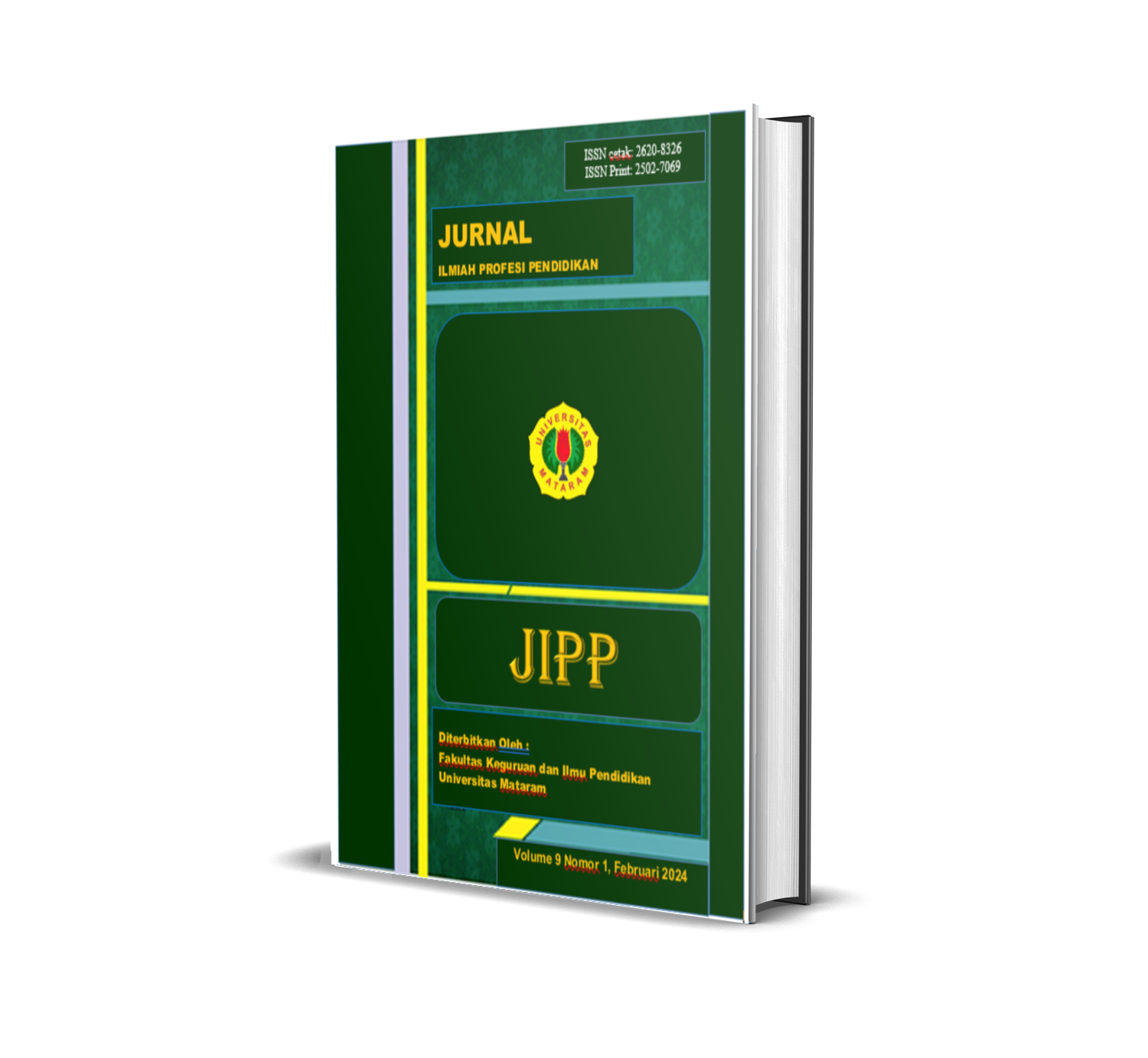Fleksibilitas dalam Berpikir Kreatif Matematis dan Aplikasi Praktis pada Pembelajaran
Penulis
Memen Permata AzmiDOI:
10.29303/jipp.v10i1.3039Diterbitkan:
2025-02-18Terbitan:
Vol 10 No 1 (2025): FebruariKata Kunci:
Konsep Fleksibilitas, Penilaian Fleksibilitas, Cara Menunjukkan Fleksibilitas, Aplikasi PraktisArticles
##submission.downloads##
Cara Mengutip
Abstrak
Fleksibilitas dalam berpikir kreatif menjadi sangat penting untuk dibahas karena berpotensi menghasilkan cara-cara yang beragam secara konseptual. Ketika fleksibilitas berpikir dikuasai, maka tercipta kepercayaan diri dan keberanian untuk mengeksplorasi gagasan baru. Dalam konteks matematika, fleksibilitas berpikir memungkinkan siswa untuk merepresentasikan masalah matematika dengan berbagai cara, seperti diagram, grafik, tabel, atau persamaan sesuai dengan pemahaman siswa kebutuhan masalah. Artikel ini membahas secara mendalam konsep fleksibilitas dalam berpikir kreatif matematis meliputi metode penilaian, cara-cara untuk menunjukkan fleksibilitas pada masalah geometri, dan penerapannya dalam situasi praktis. Artikel ini merupakan studi literatur yang mengkaji berbagai jenis artikel jurnal dan buku sehingga dihasilkan deskripsi yang mendalam. Hasil studi literatur ini menunjukkan bahwa fleksibilitas berkaitan dengan kapasitas mengubah cara dengan melihat suatu masalah dari perspektif yang berbeda-beda, Fleksibilitas diukur dengan aktivitas mengubah fokus, mencoba strategi yang berbeda, memanfaatkan representasi yang berbeda, dan menghubungkan berbagai cabang matematika. Beberapa kriteria masalah yang dapat mendukung fleksibilitas dalam berpikir, yaitu masalah terbuka, terkoneksi, visual, dan menantang. Salah satu contoh aplikasi praktis yang mendukung fleksibilitas berpikir kreatif matematis siswa adalah menggunakan pendekatan intuitif, konkret, representasi, dan abstrak.
Referensi
Abdulla, A. M., & Cramond, B. (2017). After Six Decades of Systematic Study of Creativity: What Do Teachers Need to Know About What It Is and How It Is Measured? Roeper Review, 39(1), 9–23. https://doi.org/10.1080/02783193.2016.1247398
Akpur, U. (2020). Critical, Reflective, Creative Thinking and Their Reflections on Academic Achievement. Thinking Skills and Creativity, 37, 100683. ttps://doi.org/10.1016/j.tsc.2020.100683
Barr, N., Pennycook, G., Stolz, J. A., & Fugelsang, J. A. (2015). Reasoned connections: A dual-process perspective on creative thought. Thinking & Reasoning, 21(1), 61–75. https://doi.org/10.1080/13546783.2014.895915
Bicer, A. (2021a). A systematic literature review: Discipline-specific and general instructional practices fostering the mathematical creativity of students. International Journal of Education in Mathematics, Science and Technology, 9(2), 252–281.
Bicer, A. (2021b). Multiple representations and mathematical creativity. Thinking Skills and Creativity, 42, 100960.
Bicer, A., Lee, Y., Perihan, C., Capraro, M. M., & Capraro, R. M. (2020). Considering mathematical creative self-efficacy with problem posing as a measure of mathematical creativity. Educational Studies in Mathematics, 105(3), 457–485. https://doi.org/10.1007/s10649-020-09995-8
Boccia, M., Piccardi, L., Palermo, L., Nori, R., & Palmiero, M. (2015). Where do bright ideas occur in our brain? Meta-analytic evidence from neuroimaging studies of domain-specific creativity. Frontiers in Psychology, 6, 1195.
Bruner, J. (1974). Toward a theory of instruction. Harvard university press.
Bruner, J. S. (2009). The process of education. Harvard university press.
Carlson, M. P., & Bloom, I. (2005). The Cyclic Nature of Problem Solving: An Emergent Multidimensional Problem-Solving Framework. Educational Studies in Mathematics, 58(1), 45–75. https://doi.org/10.1007/s10649-005-0808-x
Davis, R. B. (1984). Learning mathematics: The cognitive science approach to mathematics education. Norwood, N.J.: Ablex Pub. Corp. Retrieved from http://archive.org/details/learningmathemat0000davi
Delice, A., & Kertil, M. (2015). Investigating The Representational Fluency of Pre-Service Mathematics Teachers in A Modelling Process. International Journal of Science and Mathematics Education, 13(3), 631–656. https://doi.org/10.1007/s10763-013-9466-0
Denney, A. S., & Tewksbury, R. (2013). How to Write a Literature Review. Journal of Criminal Justice Education, 24(2), 218–234. https://doi.org/10.1080/10511253.2012.730617
Epstein, S. (1994). Integration of the cognitive and the psychodynamic unconscious. American Psychologist, 49(8), 709.
Evans, J. St. B. T. (2014). Two minds rationality. Thinking & Reasoning, 20(2), 129–146. https://doi.org/10.1080/13546783.2013.845605
Haylock, D. W. (1987). A framework for assessing mathematical creativity in school children. Educational Studies in Mathematics, 18(1), 59–74. https://doi.org/10.1007/BF00367914
Hensley, N. (2020). Educating for sustainable development: Cultivating creativity through mindfulness. Journal of Cleaner Production, 243, 118542.
Honeck, E. (2016). Inspiring creativity in teachers to impact students. Torrance Journal for Applied Creativity, 1(2), 33–39.
Huang, P.-S., Peng, S.-L., Chen, H.-C., Tseng, L.-C., & Hsu, L.-C. (2017). The relative influences of domain knowledge and domain-general divergent thinking on scientific creativity and mathematical creativity. Thinking Skills and Creativity, 25, 1–9.
Kahneman, D., & Frederick, S. (2002). Representativeness revisited: Attribute substitution in intuitive judgment. Heuristics and Biases: The Psychology of Intuitive Judgment, 49(49–81), 74.
Kang, R., & Liu, D. (2018). The Importance of Multiple Representations of Mathematical Problems: Evidence from Chinese Preservice Elementary Teachers’ Analysis of a Learning Goal. International Journal of Science and Mathematics Education, 16(1), 125–143. https://doi.org/10.1007/s10763-016-9760-8
Kozlowski, J. S., Chamberlin, S. A., & Mann, E. (2019). Factors that influence mathematical creativity. The Mathematics Enthusiast, 16(1), 505–540.
Krutetskii, V. A. (1976). The Psychology of Mathematical Abilities in Schoolchildren. University of Chicago Press.
Leikin, R., & Lev, M. (2007). Multiple solution tasks as a magnifying glass for observation of mathematical creativity. Proceedings of the 31st International Conference for the Psychology of Mathematics Education, 3, 161–168.
Lesh, R., Post, T. R., & Behr, M. (1987). Representations and translations among representations in mathematics learning and problem solving. In C. Janiver (Ed.), Problems of representations in the teaching and learning of mathematics (pp. 33–40). Hillsdale, NJ: Lawrence Erlbaum.
Levenson, E. S. (2022). Exploring the relationship between teachers’ values and their choice of tasks: The case of occasioning mathematical creativity. Educational Studies in Mathematics, 109(3), 469–489. https://doi.org/10.1007/s10649-021-10101-9
Levenson, E., Swisa, R., & Tabach, M. (2018). Evaluating the potential of tasks to occasion mathematical creativity: Definitions and measurements. Research in Mathematics Education, 20(3), 273–294. https://doi.org/10.1080/14794802.2018.1450777
Lin, W.-L., & Shih, Y.-L. (2022). Developmental trends of different creative potentials in relation to adolescents’ critical thinking abilities. Thinking Skills and Creativity, 43, 100979. https://doi.org/10.1016/j.tsc.2021.100979
Major, T. E., & Mangope, B. (2012). The constructivist theory in Mathematics: The case of Botswana primary schools. International Review of Social Sciences and Humanities, 3(2), 139–147.
Mann, E. L. (2005). Mathematical creativity and school mathematics: Indicators of mathematical creativity in middle school students. University of Connecticut.
Molad, O., Levenson, E. S., & Levy, S. (2020). Individual and group mathematical creativity among post–high school students. Educational Studies in Mathematics, 104(2), 201–220. https://doi.org/10.1007/s10649-020-09952-5
Partnership for 21st Century Skills. (2009). P21 framework definitions. Washington: Pearson.
Pisa, O. (2019). Creative Thinking Framework. OECD: Paris, France.
Robbins, J. K. (2011). Problem solving, reasoning, and analytical thinking in a classroom environment. The Behavior Analyst Today, 12(1), 41.
Rominger, C., Papousek, I., Weiss, E. M., Schulter, G., Perchtold, C. M., Lackner, H. K., & Fink, A. (2018). Creative Thinking in an Emotional Context: Specific Relevance of Executive Control of Emotion-Laden Representations in the Inventiveness in Generating Alternative Appraisals of Negative Events. Creativity Research Journal, 30(3), 256–265. https://doi.org/10.1080/10400419.2018.1488196
Saavedra, A. R., & Opfer, V. D. (2012). Teaching and learning 21st century skills: Lessons from the learning sciences. A Global Cities Education Network Report. New York, Asia Society, 10, 2012.
Segal, E. (2004). Incubation in Insight Problem Solving. Creativity Research Journal, 16(1),141–148. https://doi.org/10.1207/s15326934crj1601_13
Silver, E. A. (1997). Fostering creativity through instruction rich in mathematical problem solving and problem posing. ZDM–Mathematics Education, 29(3), 75–80.
Sio, U. N., & Ormerod, T. C. (2009). Does incubation enhance problem solving? A meta-analytic review. Psychological Bulletin, 135(1), 94.
Siswono, T. Y. E. (2018). Pembelajaran matematika berbasis pengajuan dan pemecahan masalah. Bandung: Remaja Rosdakarya.
Sriwongchai, A., Jantharajit, N., & Chookhampaeng, S. (2015). Developing the Mathematics Learning Management Model for Improving Creative Thinking in Thailand. International Education Studies, 8(11), 77–87.
Weber, H., Loureiro De Assunção, V., Martin, C., Westmeyer, H., & Geisler, F. C. (2014). Reappraisal inventiveness: The ability to create different reappraisals of critical situations. Cognition and Emotion, 28(2), 345–360. https://doi.org/10.1080/02699931.2013.832152
Yusoff, W. M. W., & Seman, S. C. (2018). Teachers’ knowledge of higher order thinking and questioning skills: A case study at a primary school in Terengganu, Malaysia. International Journal of Academic Research in Progressive Education and Development, 7(2).
Zed, M. (2008). Metode penelitian kepustakaan. Yayasan Pustaka Obor Indonesia.
Lisensi
Hak Cipta (c) 2025 Memen Permata Azmi

Artikel ini berlisensi Creative Commons Attribution 4.0 International License.

 klik di sini
klik di sini 
























